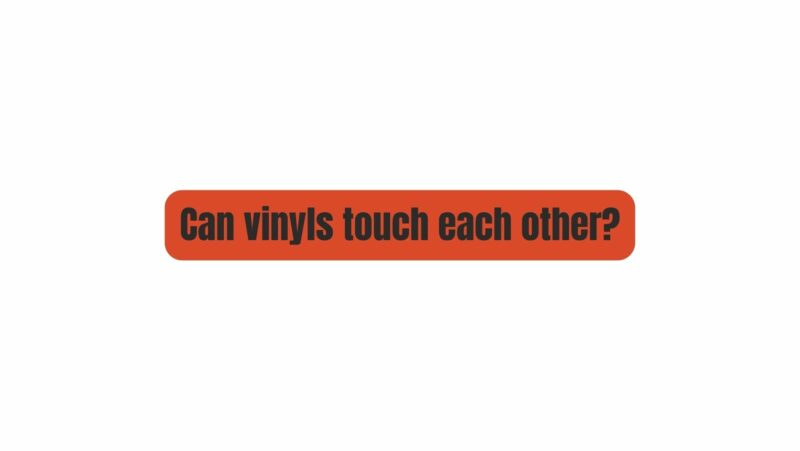Vinyl records, cherished for their warm analog sound and nostalgic appeal, have experienced a resurgence in popularity in recent years. Vinyl enthusiasts appreciate the tactile experience of handling records, from carefully placing the needle to the soft crackle that fills the room as the music plays. However, one question that often arises among vinyl collectors and enthusiasts is whether vinyl records can touch each other. In this article, we will delve into the world of vinyl storage and preservation, exploring the dos and don’ts of vinyl record care to ensure your cherished collection stands the test of time.
The Anatomy of a Vinyl Record:
To understand whether vinyl records can touch each other, it’s essential to comprehend the structure of a vinyl record. A standard vinyl record is composed of several layers:
- Vinyl Groove: This is the part of the record where the audio information is physically encoded. It consists of a spiral groove that spirals inward from the outer edge to the center.
- Vinyl Platter: The vinyl groove is typically pressed onto a circular vinyl platter, providing the record’s rigidity and shape.
- Label: In the center of the record is a label, which is often where information about the artist, album, and tracklist is printed.
- Outer Edge: The outer edge of the vinyl record is where the grooves begin and is usually the part that first contacts the turntable’s stylus.
- Inner Groove: Toward the center of the record, the grooves become narrower and closer together. This area contains the last tracks on the album.
With this understanding of a vinyl record’s structure, let’s explore whether vinyl records can touch each other and why this is a subject of concern for collectors.
The Risks of Vinyl Records Touching Each Other:
Vinyl records are delicate, and any damage to their surface can result in a loss of audio quality or even rendering the record unplayable. When vinyl records touch each other, several risks arise:
- Surface Scratches: The most immediate risk is surface scratches. When two vinyl records come into contact, the friction between them can lead to small scratches on the grooves. Even minor scratches can cause audible pops and crackles during playback.
- Warps: Vinyl records can warp when exposed to heat, pressure, or uneven weight distribution. Stacking records on top of each other or allowing them to touch can exacerbate warping, leading to the record being unplayable.
- Static Buildup: Vinyl records can accumulate static electricity, which attracts dust and dirt. When records touch each other, this static buildup can transfer, increasing the risk of attracting debris that can damage the grooves.
- Mold and Mildew: Storing vinyl records in a humid environment can lead to mold and mildew growth. When records touch each other, they create an ideal environment for moisture retention, potentially causing irreversible damage.
Best Practices for Vinyl Record Storage:
To preserve your vinyl record collection and ensure that they do not touch each other, follow these best practices for vinyl record storage:
- Use Proper Sleeves: Invest in high-quality inner and outer sleeves for your vinyl records. Inner sleeves protect the record surface from dust and static, while outer sleeves provide an extra layer of protection against handling and environmental factors.
- Vertical Storage: Store your vinyl records vertically, like books on a shelf. This prevents the records from pressing against each other and minimizes the risk of warping.
- Record Dividers: Use record dividers to keep records separated within your storage unit. This helps prevent them from leaning or touching.
- Maintain Temperature and Humidity: Keep your vinyl records in a stable environment with controlled temperature and humidity levels. Extreme heat and humidity can lead to warping and mold growth.
- Avoid Overpacking: Avoid overpacking your record shelves or storage units. Leave enough space between records to prevent pressure and friction.
- Handle Records Carefully: Always handle your vinyl records with clean hands, and hold them by the edges or the label. Avoid touching the grooves.
- Clean Records Regularly: Clean your vinyl records regularly using a record cleaning brush or a specialized cleaning solution. Clean records are less likely to produce pops and crackles during playback.
Conclusion:
In conclusion, vinyl records should not touch each other to ensure their long-term preservation and audio quality. The delicate grooves of vinyl records are susceptible to damage from surface scratches, warping, static buildup, and environmental factors. By following the best practices for vinyl record storage, including using proper sleeves, maintaining a stable environment, and handling records with care, collectors can enjoy their vinyl collections for years to come without worrying about the records touching each other. Preserving the integrity of these analog treasures is essential for future generations to appreciate the magic of vinyl’s warm and timeless sound.


